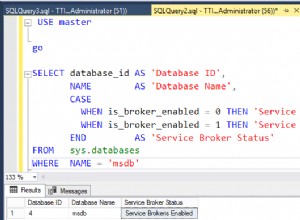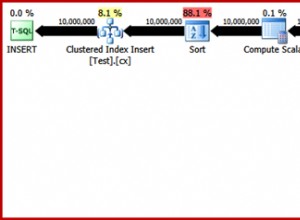L'errore è dovuto a HibernateTemplate aprendo una sessione di ibernazione per eseguire questa query:
List results = hibernateTemplate.find("from database.Document d where d.name = 'doc1'");
e quindi chiudere immediatamente la sessione dopo l'esecuzione della query. Quindi, durante il ciclo delle chiavi, la sessione a cui era collegata la mappa viene chiusa in modo che i dati non possano più essere caricati, facendo sì che il proxy generi LazyInitializationException .
Questa eccezione significa che il proxy non può più caricare i dati in modo trasparente perché la sessione a cui è anche collegato è ora chiusa.
Uno degli obiettivi principali di HibernateTemplate è sapere quando aprire e chiudere le sessioni. Il modello manterrà la sessione aperta se è in corso una transazione.
Quindi la chiave qui è racchiudere lo unit test in un TransactionTemplate (il modello equivalente a @Transactional ), che fa sì che la sessione venga mantenuta aperta da HibernateTemplate . Poiché la sessione viene mantenuta aperta, non si verificano più eccezioni di inizializzazione pigra.
Modificare il test in questo modo risolverà il problema (notare l'uso di TransactionTemplate ):
import database.Document;
import database.PkgItem;
import org.junit.After;
import org.junit.Assert;
import org.junit.Before;
import org.junit.Test;
import org.springframework.core.io.ClassPathResource;
import org.springframework.core.io.Resource;
import org.springframework.orm.hibernate3.HibernateTemplate;
import org.springframework.orm.hibernate3.HibernateTransactionManager;
import org.springframework.orm.hibernate3.LocalSessionFactoryBean;
import org.springframework.transaction.PlatformTransactionManager;
import org.springframework.transaction.TransactionStatus;
import org.springframework.transaction.support.TransactionCallbackWithoutResult;
import org.springframework.transaction.support.TransactionTemplate;
import java.util.HashMap;
import java.util.List;
import java.util.Set;
public class HibernateMapTest {
private static final String TEST_DIALECT = "org.hibernate.dialect.HSQLDialect";
private static final String TEST_DRIVER = "org.hsqldb.jdbcDriver";
private static final String TEST_URL = "jdbc:hsqldb:mem:adportal";
private static final String TEST_USER = "sa";
private static final String TEST_PASSWORD = "";
private HibernateTemplate hibernateTemplate;
private TransactionTemplate transactionTemplate;
@Before
public void setUp() throws Exception {
hibernateTemplate = new HibernateTemplate();
LocalSessionFactoryBean sessionFactory = new LocalSessionFactoryBean();
sessionFactory.getHibernateProperties().put("hibernate.dialect", TEST_DIALECT);
sessionFactory.getHibernateProperties().put("hibernate.connection.driver_class", TEST_DRIVER);
sessionFactory.getHibernateProperties().put("hibernate.connection.password", TEST_PASSWORD);
sessionFactory.getHibernateProperties().put("hibernate.connection.url", TEST_URL);
sessionFactory.getHibernateProperties().put("hibernate.connection.username", TEST_USER);
sessionFactory.getHibernateProperties().put("hibernate.hbm2ddl.auto", "create");
sessionFactory.getHibernateProperties().put("hibernate.show_sql", "true");
sessionFactory.getHibernateProperties().put("hibernate.jdbc.batch_size", "0");
sessionFactory.getHibernateProperties().put("hibernate.cache.use_second_level_cache", "false");
sessionFactory.setMappingDirectoryLocations(new Resource[]{new ClassPathResource("database")});
sessionFactory.afterPropertiesSet();
hibernateTemplate.setSessionFactory(sessionFactory.getObject());
transactionTemplate = new TransactionTemplate(new HibernateTransactionManager(sessionFactory.getObject()));
}
@After
public void tearDown() throws Exception {
hibernateTemplate.getSessionFactory().close();
}
@Test
public void testFetchEntityWithMap() throws Exception {
transactionTemplate.execute(new TransactionCallbackWithoutResult() {
protected void doInTransactionWithoutResult(TransactionStatus status) {
// Store the entities and mapping
PkgItem key = new PkgItem();
key.setName("pkgitem1");
hibernateTemplate.persist(key);
Document doc2 = new Document();
doc2.setName("doc2");
hibernateTemplate.persist(doc2);
Document doc1 = new Document();
doc1.setName("doc1");
HashMap<PkgItem, Document> documentbundles = new HashMap<PkgItem, Document>();
documentbundles.put(key, doc2);
doc1.setDocumentbundles(documentbundles);
hibernateTemplate.persist(doc1);
// Now attempt a query
List results = hibernateTemplate.find("from database.Document d where d.name = 'doc1'");
Document result = (Document)results.get(0);
// Check the doc was returned
Assert.assertEquals("doc1", result.getName());
key = (PkgItem)hibernateTemplate.find("from database.PkgItem").get(0);
Set<PkgItem> bundleKeys = result.getDocumentbundles().keySet();
// Check the key is still present in the map. At this point the test fails because
// the map contains a proxy object of the key...
Assert.assertEquals(key, bundleKeys.iterator().next());
}
});
}
}
e questi sono i risultati del test e il registro dopo la modifica:





